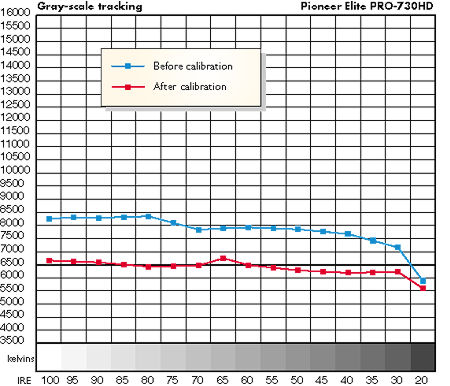Pioneer Elite PRO-730HD rear-projection CRT TV Calibration
The Pioneer Elite PRO-730HD shipped with factory settings that were very close to ideal. It didn't need extensive work to be palatable to all but the most attentive enthusiast.

I'm always concerned about demo units being "ringers"—review samples calibrated to a more exacting standard than a set yanked at random off the assembly line. A Chicago client hired me to perform a full calibration on his PRO-730HD not long after my own sample arrived, so I had the chance to see a regular production sample—as our review units are supposed to be. Out of the box, his sample measured about the same as mine. And for the experienced calibrator who wishes to do a complete setup, the Pioneer service menu is now easily accessible for each of the input modes and aspect ratios.
Pioneer has always known black, and the PRO-730HD continues that tradition. It held a solid black level well, regardless of the overall scene illumination. At the factory settings, the Needle Pulse pattern had only a slight bend where the black and white areas meet, indicating a slightly overdriven but well-regulated power supply.
Pioneer claims a high peak-white output of 360 footlamberts, a factor of 10 higher than the brightest measurement I could obtain using my Minolta light meter. I couldn't get enough information about Pioneer's factory measurement tools and techniques to understand the differences.
With its contrast lowered to produce an output level of 19fL peak white, the PRO-730HD had good detail. But most of my viewing was in Pioneer's Reference Theater mode, which had a peak-white value of 9fL and an even more focused beam, the result being incredible detail. I did notice some internal reflections, including a diagonal slash through the lower half of the picture when displaying a PLUGE pattern. This set would benefit from internal treatment with nonreflective materials such as Duvatyne cloth—a job for an experienced calibrator.
One tradition I'd like to see end is Pioneer's incorrect color decoder. For years, they've rendered yellow with a slight orange tint—like a school bus—and greens have been a bit undersaturated. These deviations were visible on the PRO-730HD, including through its DVI input.
The Pioneer Elite PRO-730HD's gray-scale performance (the "After" settings were calibrated in the service menu) is shown in the accompanying figure; the peak white level was 9fL.—JJG
- Log in or register to post comments






























































